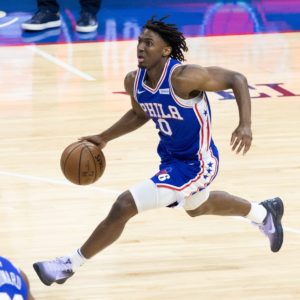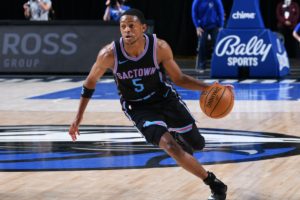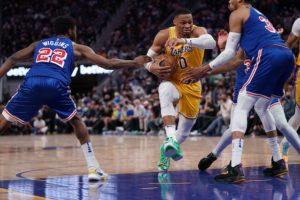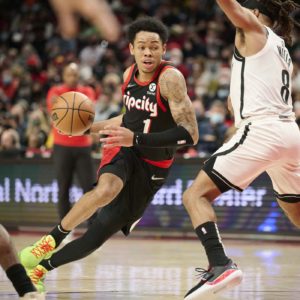Hoopers Who Would be Good Hurdlers
by Steve McGill
In the sports realm, professional basketball players in the NBA are widely considered to be the greatest athletes in the world. The combination of speed, strength, and agility that can be found among the top NBA players is indeed astounding. These days, I can’t help but watch NBA games on TV and wonder how fast certain players could run a hurdle race. When I was in college, Michael Jordan was in the early stages of his career with the Chicago Bulls, and I remember my coach saying one day, “Can you imagine what that guy could do in the triple jump?” Another time, I was watching in person as the Philadelphia 76ers, who held their training camp back then at the college I was attending, held a practice session that was open to the public. In the layup line, a skinny rookie named Sedale Threatt (who ended up having a pretty long career, but was an unknown commodity at the time) casually jumped up and tapped the square on the backboard. These two moments inspired what has become a bit of an obsession with fantasizing about which NBA players could be standouts in the hurdles.
[am4show not_have=’g5;’]
[/am4show][am4guest]
[/am4guest][am4show have=’g5;’]
More recently, I attended a game in Charlotte, NC, about 30 minutes from where I currently live, in a game against my 76ers. The Hornets were undermanned due to Covid infections, as this was at the height of the Omicron variant’s wave, so they had to use players who usually didn’t receive much playing time. One of these players was a young rookie they had recently brought up from the G League named James Bouknight. I had no idea who this dude was until, on one play in the second or third quarter, he jumped so high that his head was nearly even with the middle of the backboard, and he threw down a put-back dunk so hard that it felt like a mini-earthquake. And the first thought that entered my mind was, Man, I wonder what this dude could run in the hurdles!
It’s interesting to note that there have been many more professional football players than basketball players who have had success in the hurdles at some level. Obvious names that come to mind are Renaldo Nehemiah, Willie Gault, David Oliver, Roger Kingdom, Rod Woodson, Ted Ginn, and Robert Griffin III, just off the top of my head, all of whom had significant success in both sports. In my own career in coaching at the high school level, I’ve had many football players who ran the hurdles for me, but I can’t think of one hurdler I’ve coached who took basketball seriously. Well, there is one kid I coached last summer, but he was only 11 years old, and I’m sure he’ll have to decide between the two at some point, probably sooner than later. Part of the reason that not many hoopers become hurdlers is because the seasons overlap too much, whereas there’s a full season between football season and outdoor track season. Also, more and more hoopers are playing basketball year-round, which basically leaves no time for participation in any other sports. And then there’s the fact that many of the best basketball players are so tall that it just makes more sense to stick with basketball.
The only professional basketball player I know of who had success as a hurdler was the dynamic point guard Nate Robinson, who played for various teams in a career that spanned from 2005 to 2015, including the 2010 Boston Celtics squad that lost a seven-game series to the Kobe Bryant-led Los Angeles Lakers. In high school, Robinson ran 13.85 in the 110h and 38.18 in the 300h. Not ridiculously fast, but that 110 time is fast enough that he could’ve had a future as a hurdler and could have potentially reached the elite level. So when I look at modern NBA players, who do I think have what it takes to be a great hurdler? Here’s a short list:
Tyrese Maxey
 Yes I’m partial to Maxey because the second-year guard plays for the 76ers, but I gotta tell you, when I see Maxey putting on huge burst of speed and sprinting past defenders for easy layups on a nightly basis, I know this dude could run the 110’s in the low 13’s. At 6-2, he’s the ideal height for a hurdler, and he has a muscular but wiry frame that indicates his combination of flexibility and strength. Maxey is also a high-IQ guy who likes to soak up knowledge from all available sources. And with the hurdles being such a cerebral event, it would fit him perfectly.
Yes I’m partial to Maxey because the second-year guard plays for the 76ers, but I gotta tell you, when I see Maxey putting on huge burst of speed and sprinting past defenders for easy layups on a nightly basis, I know this dude could run the 110’s in the low 13’s. At 6-2, he’s the ideal height for a hurdler, and he has a muscular but wiry frame that indicates his combination of flexibility and strength. Maxey is also a high-IQ guy who likes to soak up knowledge from all available sources. And with the hurdles being such a cerebral event, it would fit him perfectly.
De’Aaron Fox
I like the Sacramento Kings’ Fox, another Kentucky guy who played under John Calipari, for the same reason I like Maxey: he’s really, really fast. At 6-3, he would have a little more trouble

fitting in his three steps between the hurdles, but I’m sure that the instincts he displays on the basketball court when dribbling between defenders would translate to negotiating the space between the hurdles. Fox and Maxey would be speed-first types of hurdlers like a Grant Holloway or a Terrence Trammell, who both had/have exceptional speed but also had/have some minor technical flaws.
 Russell Westbrook
Russell Westbrook
A future hall of famer who is a bit of a controversial figure because of his nonstop full throttle style of play, this dude would be a monster in the hurdles. Westbrook, who currently plays for the Los Angeles Lakers but played his best basketball while leading the Oklahoma City Thunder to extended playoff runs for many years, has that mentality that all hurdle coaches crave from their hurdlers — an I-don’t-give-a-damn, I’m-coming-at-you mentality. Westbrook is always in attack mode, never slowing down and never backing down. If a big man is standing in front of the rim, Westbrook will drive right into his chest. He plays basketball with the mindset of a free safety in football, or better yet, with the mindset of a hurdler who is more concerned about getting to the finish line first than he is about looking pretty. If Westbrook were a hurdler, he’d be a Roger Kingdom or David Oliver type of guy. At 6-3, with exceptional upper body strength, he could clobber hurdles and it wouldn’t affect him.
 Darius Garland & Anfernee Simons
Darius Garland & Anfernee Simons
I’m grouping these two guys together because I like the same thing about them — their fluidity, their ease of motion, and the efficiency of their movements. Garland of the Cleveland Cavaliers and Simons of the Portland Trailblazers are both young players who are having break-out years. Garland has had more opportunity due to the season-ending injury of his backcourt mate Collin Sexton, and Simon similarly has benefitted from the season-ending injury of Portland’s superstar point guard Damian Lillard. Garland and Simons might be just a tad slower than Fox and Maxey, and not as strong as Westbrook, but they make up for it with their fluidity of motion. If these two guys were hurdlers, they would most likely resemble someone like Orlando Ortega, or, if you wanna go old-school, someone like Jack Pierce.

To conclude, I would say that in discussing these hoopers who I feel would make excellent hurdlers, you may have noticed that I’ve pinpointed some key elements to what it takes to be an outstanding hurdler. Speed always comes first; there’s no such thing as being too fast in the hurdles, because, if you’re coached well, you can always learn to manage your speed so that it helps you instead of hindering you. Then there’s gotta be the mindset, the fierce attitude, that cannot be coached but has to come from within. And then there’s the fluidity aspect — the ability to minimize extraneous effort so that all effort is being maximized. Put together the speed with the mentality with the fluidity, and you have a beast of a hurdler. Grant Holloway is the closest thing to it among today’s hurdlers when he’s at the top of his game.
[/am4show]
